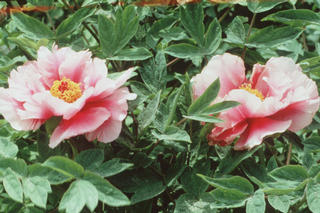Paeonia suffruticosa
Contents
Nomenclature
Other Names:
Historical Use of Paeonia suffruticosa
Paeonia suffruticosa in Traditional Chinese Medicine
Background
Danpitan µ¤Æ¤Ì¿
Fendanpi ·Ûµ¤Æ¤
Jiudanpi ¾Æµ¤Æ¤
Chinese Name (pinyin): Mudanpi
Chinese Name :
Common Name :Moutan Bark
Specific Name : Cortex moutan
Scientific Name:
Collection : The root is collected in autumn, removed from the rootlets, the root bark is stripped off and dried in the sun.
Description : Quilled or semiquilled, longitudinally fissured, somewhat involute or opened, 5-20cm long, 5-12mm in diameter, 1-4mm thick. The outer surface greyish-brown, showing numerous transverse lenticels and rootlet scars, the exposed layer where cork fallen off appearing pink, the inner surface greyish-yellow or brownish with obvious fine longitudinal striations, usually showing bright crystals. Texture hard and fragile, easily broken, fracture relatively even, starchy, pale pink, odour aromatic, taste slightly bitter and astringent.
Identification : 1.Powder: Pale reddish brown, starch granules fairly abundant, simple granules subrounded or polygonal, 3-6µm in diameter, hilum pointed, cleft or V-shaped, compound granules of 2-6 components. Clusters of calcium oxalate 9-45µm in diameter, sometimes crystal cells joined arranged in rows or several clusters in one cell. Cork cells rectangular, slightly thick walled, pale red.2.Shake 0.15 of the powder with 25ml of dehydrated ethanol for several minutes and filter. Dilute 1ml of the filtrate to 25ml of dehydrated ethanol. Carry out the method for spectrophotometry (Appendix V A). The light absorption exhibits a maximum at 274nm.3.Shake 1g of the powder with 10ml of ether for 10 minutes and filter. Evaporate the filtrate to dryness, to the residue add 2ml of acetone as the test solution. Dissolve paeonol CRS in acetone to produce a solution containing 5mg per ml as the reference solution. Carry out the method for thin layer chromatography (Appendix Vl B) using silica gel G as the coating substance and cyclohexane-ethyl acetate (3:1) as the mobile phase. Apply separately to the plate 10µl of each of the two solutions. After developing and removal of the plate, dry it in the air and spray with a 5% solution of ferric chloride in ethanol acidified with hydrochloric acid. Dry the plate with a current or hot air until the spots are observe clearly. A bluish brown spot is shown in the chromatogram obtained with the test solution correspond in position and colour with the spot in the chromatogram obtained with the reference solution.Water: Carry out the determination of water (Appendix lX H, mathod 2) not more than 13.0%Total Ash: Not more than 5.0% (Appendix lX K).Assay: Distill 0.2g of the powder, accurately weighed with steam, collect about 450ml of distillate, dilute 500ml with water and shake well. Carry out the method for spectrophotomery (Appendix V A) measure the absorbance of the solution at 274nm and calculate the content of C9H10O3, taking 862 as the value of A (1%, 1cm). It contains not less than 1.20% of paeonol (C9H10O3,) calculated on the dried basis.
Processing : Wash rapidly, soften cut into slices and dry in the sun.
Action : To remove heat from blood, to activate blood circulation and eliminate blood stasis.
Indication : eruptions in epidemic diseases; spitting of blood, epistaxis; consumptive fever occurring at night and subsiding in the mornin without sweating; amenorrhea, dysmenorrhea; carbuncles and sores; traumatic injuries
Precautions :
Dosage : 6 to 12 g.
Storage : Preserve in a cool and dry place.
Synonymns for Paeonia suffruticosa
Patent Medicines and Medicines with Multiple Ingredients that include Paeonia suffruticosa
Pharmaceutical Information
Chemical Constituents
Evidence or the Use of Paeonia suffruticosa in the Treatment of Epilepesy
Basic Science
Animal Studies
Cohort, Case-Control and Non-Randomized Trials
Randomized Controlled Trials
Meta-Analysis
1st Five Results: pubmed search
Weiling Gai, Chunying Liu, Mengjie Yang, Feng Li, Hua Xin, Shupeng Gai
Calcium signaling facilitates chilling- and GA- induced dormancy release in tree peony.
Front Plant Sci: 2024, 15;1362804
[PubMed:38567129]
[WorldCat.org]
[DOI]
(P e)
Xingyu Yang, Yu Huang, Yiping Yao, Wenxuan Bu, Minhuan Zhang, Tangchun Zheng, Xiaoning Luo, Zheng Wang, Weiqun Lei, Jianing Tian, Lujie Chen, Liping Qin
Mining Heat-Resistant Key Genes of Peony Based on Weighted Gene Co-Expression Network Analysis.
Genes (Basel): 2024, 15(3);
[PubMed:38540443]
[WorldCat.org]
[DOI]
(I e)
Menglong Gao, Lishun Dong, Yulong Yang, Jinjin Yan, Yuning Liang, Xiaolin Ma, Min Zhou, Hongfei Wu, Yarong Liu, Min Dai
The anti-atherosclerotic effect of Paeonol against the lipid accumulation in macrophage-derived foam cells by inhibiting ferroptosis via the SIRT1/NRF2/GPX4 signaling pathway.
Biochem Biophys Res Commun: 2024, 708;149788
[PubMed:38518720]
[WorldCat.org]
[DOI]
(I p)
Woo Chang Kang, Yong Seung Lee, Keontae Park, Chang Hyeon Kong, Mijin Jeon, Min Seo Kim, Seo Yun Jung, Jung Hye Choi, Jong Hoon Ryu
Paeonol alleviates postmenopause-induced neuropsychiatric symptoms through the modulation of GPR30 in ovariectomized mice.
J Ethnopharmacol: 2024, 327;118063
[PubMed:38493906]
[WorldCat.org]
[DOI]
(I p)
Xingrong Xie, Yatong Zhou, Ziqi Tang, Xinping Yang, Qi Lian, Jihua Liu, Boyang Yu, Xiufeng Liu
##Title##
J Agric Food Chem: 2024, 72(12);6265-6275
[PubMed:38487839]
[WorldCat.org]
[DOI]
(I p)

